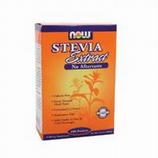
 Regular Retail: $8.99
Regular Retail: $8.99Antonio Bertoni, a South American scientist, is credited with the modern discovery of Stevia in 1887, when he first observed Indians of the Guarani tribe of Paraguay use it to flavor bitter tribal beverages. Bertoni erroneously classified Stevia as a member of the daisy family, but it was later re-assigned to the chrysanthemum family in 1905. Twenty-five years later, two French chemists conducting research on Stevia isolated the chemical constituent responsible for Stevia's flavorful properties and named it stevioside.
Today, Stevia is cultivated in over a dozen countries worldwide. It is a major export product and is widely used in countries such as China, Brazil, Northa nd South Korea, Taiwan, Israel, Paraguay and Malaysia. Stevia has also been grown successfully in California, southern Ontario, Canada and even southern England. Although there are several different species of Stevia, the most potent and effective seems to be Stevia rebaudiana, and this species is used in most dietary supplements on the market today.
A sweet secret cannot be kept forever!
Since 1968 NOW has been a dedicated source of high quality, affordable natural foods, vitamins and pure cosmetics. We search worldwide for the best products at the best prices. No compromises, no added costs, no unnecessary frills.
We continue to provide certified organic or natural foods, grains, flours and seeds through health food stores. As a family owned and operated business, we offer the health-conscious consumer three generations of honesty, quality, purity and commitment.
Other Ingredients: Rice Maltodextrin and Silica.
Free of: sugar, salt, yeast, wheat, gluten, corn, soy, milk, egg, shellfish, preservatives, artificial colors or artificial flavors.
Stevia rebaudiana FAQ's
What is Stevia rebaudiana?
Stevia is an herb indigenous to Paraguay and Brazil that grows 2--3 feet tall and resembles mint in appearance. The South American native Guarani Indians used this green “sweet herb” they called “kaa he-he” for centuries before a European botanist named M.S. Bertoni first learned of this unique plant from the native guides while exploring Paraguay in 1887. Though prior to the early 1900s Stevia was a plant harvested in the wild it soon thereafter was being grown in abundance on plantations.
Sometime between 1918 and 1921 the USDA was introduced to this wonderfully sweet herb but because of political and other interests Stevia was not accepted as a natural sweetener. The compounds in Stevia that give the herb its sweet taste called Steviosides were isolated by French scientists in 1931. Since the 1970s Japan has approved and used Stevia extracts as a sweetener in everything from ice cream to soft drinks.
Today in the<
Note:
Product image may vary in look, size, quantity and/or flavor. It should only be used as a reference. Please check with the manufacturer for the most up-to-date product information.
Although we try very hard to keep the product information up-to-date, occasionally, the manufacturer changes the name and the packaging of a product without notice.
Share your thought and comments. Be the first to write a review.